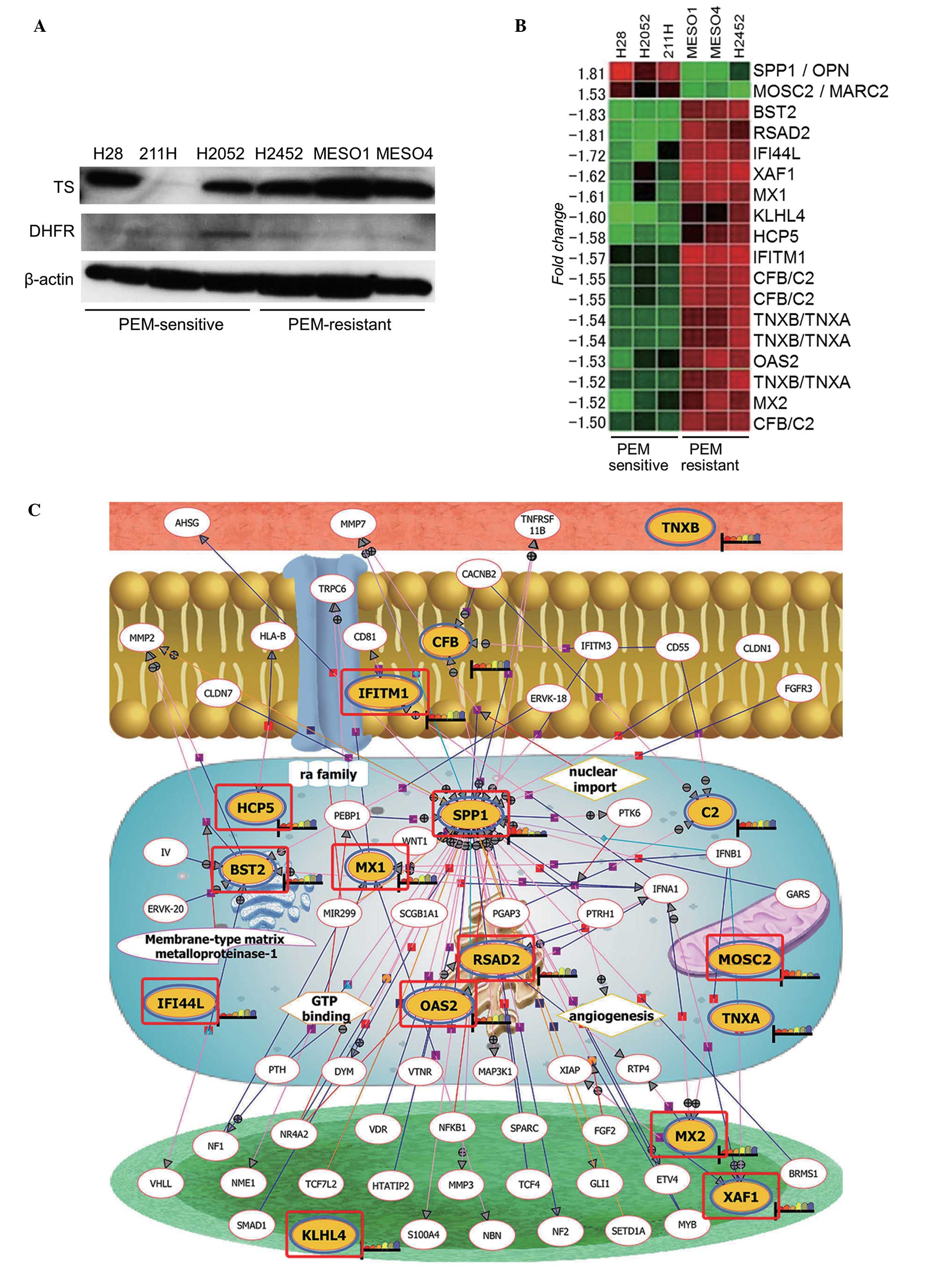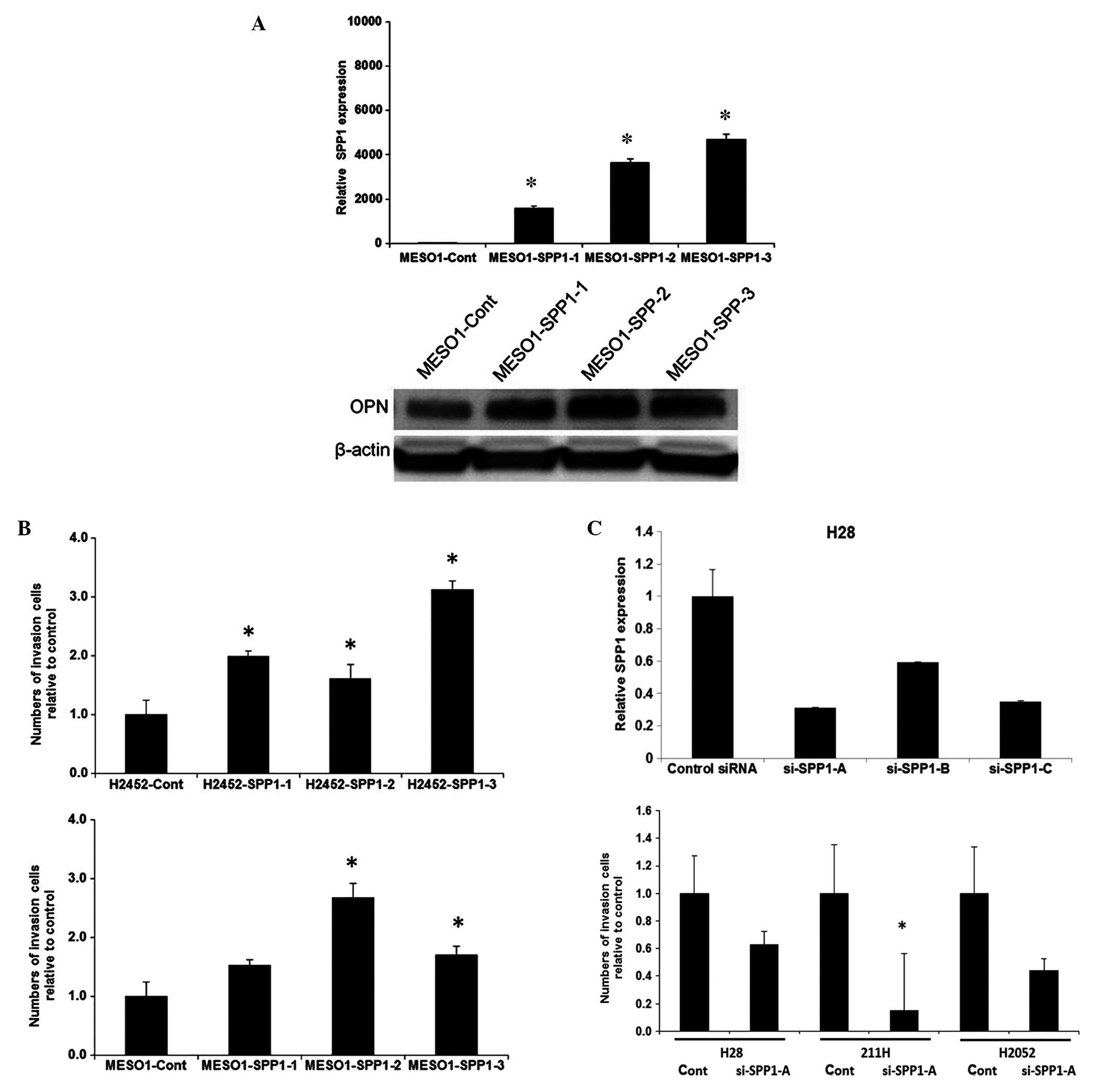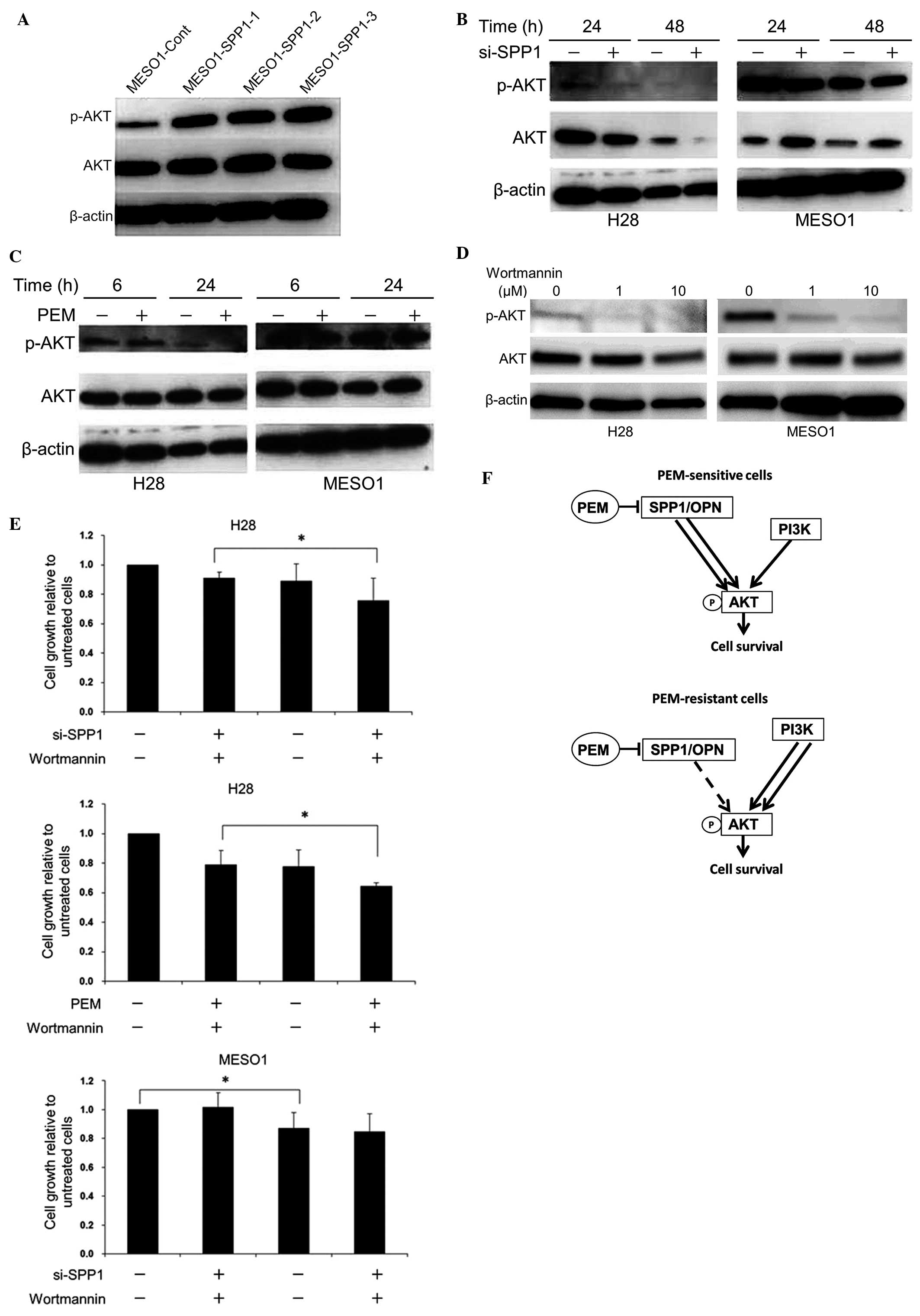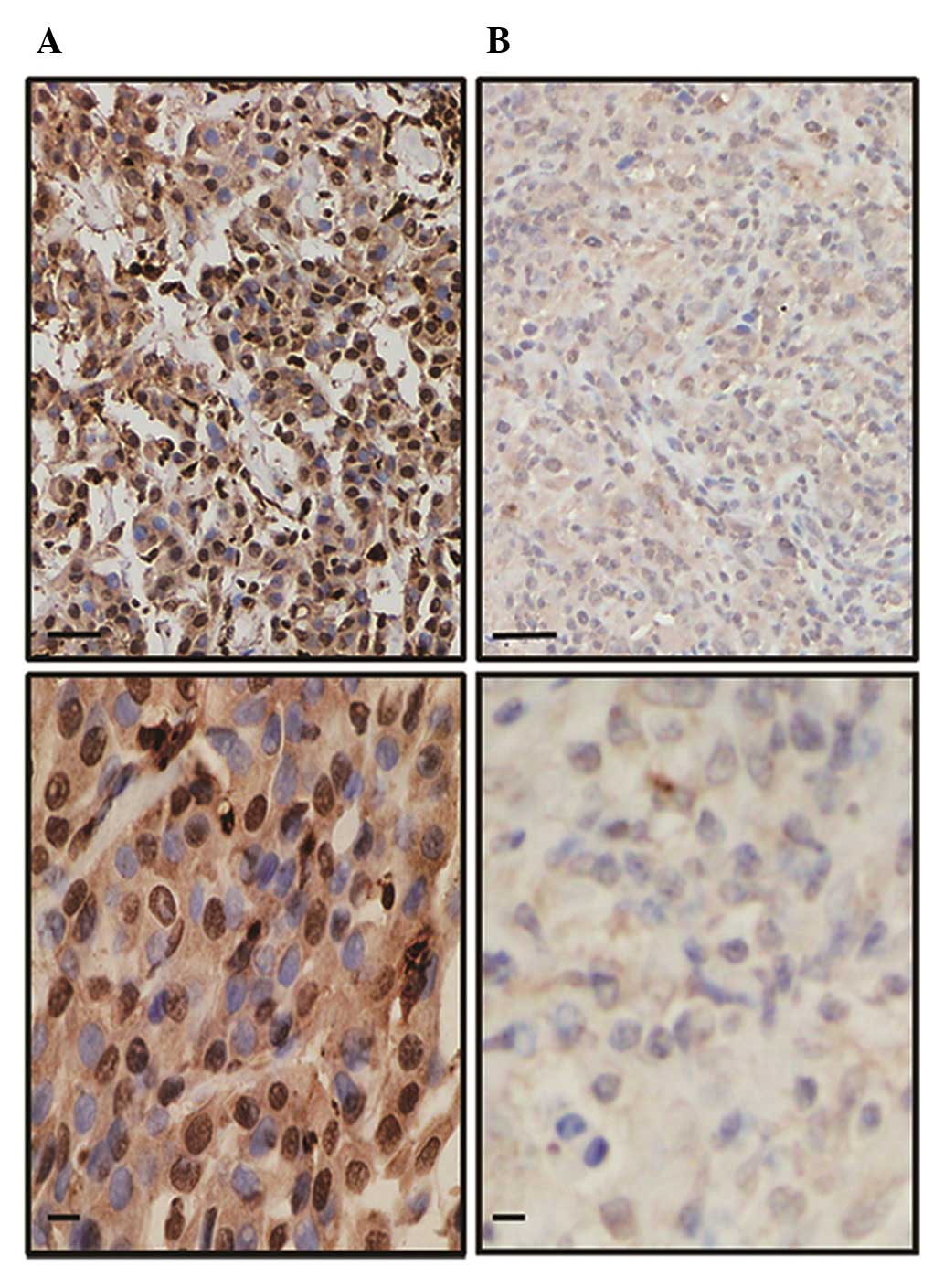|
1.
|
Hansen J, de Klerk NH, Musk AW and Hobbs
MS: Environmental exposure to crocidolite and mesothelioma:
exposure-response relationships. Am J Respir Crit Care Med.
157:69–75. 1998. View Article : Google Scholar : PubMed/NCBI
|
|
2.
|
Robinson BWS and Lake RA: Advances in
malignant mesothelioma. N Engl J Med. 353:1591–1603. 2005.
View Article : Google Scholar : PubMed/NCBI
|
|
3.
|
Vogelzang NJ, Rusthoven JJ, Symanowski J,
et al: Phase III study of PEM in combination with cisplatin versus
cisplatin alone in patients with malignant pleural mesothelioma. J
Clin Oncol. 21:2636–2644. 2003. View Article : Google Scholar : PubMed/NCBI
|
|
4.
|
Shimokawa T, Seike M, Gemma A, et al:
Enzastaurin has anti-tumour effects in lung cancers with
overexpressed JAK pathway molecules. Br J Cancer. 106:867–875.
2012. View Article : Google Scholar : PubMed/NCBI
|
|
5.
|
Seike M, Yanaihara N, Bowman ED, et al:
Use of a cytokine gene expression signature in lung adenocarcinoma
and the surrounding tissue as a prognostic classifier. J Natl
Cancer Inst. 15:1257–1269. 2007. View Article : Google Scholar : PubMed/NCBI
|
|
6.
|
Seike M, Goto A, Harris CC, et al: MiR-21
is an EGFR-regulated anti-apoptotic factor in lung cancer in
never-smokers. Proc Natl Acad Sci USA. 21:12085–12090. 2009.
View Article : Google Scholar : PubMed/NCBI
|
|
7.
|
Gemma A, Li C, Kudoh S, et al: Anticancer
drug clustering in lung cancer based on gene expression profiles
and sensitivity database. BMC Cancer. 6:1742006. View Article : Google Scholar : PubMed/NCBI
|
|
8.
|
Miyanaga A, Gemma A, Kudoh S, et al:
Antitumor activity of histone deacetylase inhibitors in non-small
cell lung cancer cells: development of a molecular predictive
model. Mol Cancer Ther. 7:1923–1930. 2008. View Article : Google Scholar : PubMed/NCBI
|
|
9.
|
Kikuchi S, Honda K, Yamada T, et al:
Expression and gene amplification ofactinin-4 in invasive ductal
carcinoma of the pancreas. Clin Cancer Res. 14:5348–5356. 2008.
View Article : Google Scholar : PubMed/NCBI
|
|
10.
|
McCarty KS Jr, Miller LS, Cox EB, Konrath
J and McCarty KS Sr: Estrogen receptor analyses. Correlation of
biochemical and immunohistochemical methods using monoclonal
antireceptor antibodies. Arch Pathol Lab Med. 109:716–721.
1985.
|
|
11.
|
Shih C, Chen VJ, Gossett LS, et al:
LY231514, a pyrrolo [2,3-d] pyrimidine-based antifolate that
inhibits multiple folate-requiring enzymes. Cancer Res.
57:1116–1123. 1997.
|
|
12.
|
Tajima K, Ohashi R, Sekido Y, et al:
Osteopontin-mediated enhanced hyaluronan binding induces multidrug
resistance in mesothelioma cells. Oncogene. 29:1941–1951. 2010.
View Article : Google Scholar : PubMed/NCBI
|
|
13.
|
Ozasa H, Oguri T, Uemura T, Miyazaki M,
Maeno K, Sato S and Ueda R: Significance of thymidylate synthase
for resistance to PEM in lung cancer. Cancer Sci. 101:161–166.
2010. View Article : Google Scholar : PubMed/NCBI
|
|
14.
|
Righi L, Papotti MG, Ceppi P, et al:
Thymidylate synthase but not excision repair cross-complementation
group 1 tumor expression predicts outcome in patients with
malignant pleural mesothelioma treated with PEM-based chemotherapy.
J Clin Oncol. 28:1534–1539. 2010. View Article : Google Scholar
|
|
15.
|
Assaraf YG: Molecular basis of antifolate
resistance. Cancer Metastasis Rev. 26:153–181. 2011. View Article : Google Scholar
|
|
16.
|
Baliga SS, Merrill GF, Shinohara ML and
Denhardt DT: Osteopontin expression during early cerebral
ischemia-reperfusion in rats: enhanced expression in the right
cortex is suppressed by acetaminophen. PLoS One. 6:e145682011.
View Article : Google Scholar
|
|
17.
|
Rangaswami H, Bulbule A and Kundu GC:
Osteopontin: role in cell signaling and cancer progression. Trends
Cell Biol. 16:79–87. 2006. View Article : Google Scholar : PubMed/NCBI
|
|
18.
|
Donati V, Boldrini L, Fontanini G, et al:
Osteopontin expression and prognostic significance in non-small
cell lung cancer. Clin Cancer Res. 18:6459–6465. 2005. View Article : Google Scholar : PubMed/NCBI
|
|
19.
|
Tuck AB and Chambers AF: The role of
osteopontin in breast cancer: clinical and experimental studies. J
Mammary Gland Biol Neoplasia. 6:419–429. 2001. View Article : Google Scholar : PubMed/NCBI
|
|
20.
|
Thalmann GN, Sikes RA, Devoll RE, et al:
Osteopontin: possible role in prostate cancer progression. Clin
Cancer Res. 5:2271–2277. 1999.PubMed/NCBI
|
|
21.
|
Agrawal D, Chen T, Irby R, et al:
Osteopontin identified as lead marker of colon cancer progression,
using pooled sample expression profiling. J Natl Cancer Inst.
94:513–521. 2002. View Article : Google Scholar : PubMed/NCBI
|
|
22.
|
Kim J-H, Skates SJ, Uede T, et al:
Osteopontin as a potential diagnostic biomarker for ovarian cancer.
JAMA. 287:1671–1679. 2002. View Article : Google Scholar : PubMed/NCBI
|
|
23.
|
Ue T, Yokozaki H, Kitadai Y, Yamamoto S,
Yasui W, Ishikawa T and Tahara E: Co-expression of osteopontin and
CD44v9 in gastric cancer. Int J Cancer. 79:127–132. 1998.
View Article : Google Scholar : PubMed/NCBI
|
|
24.
|
Pass HI, Lott D, Lonardo F, et al:
Asbestos exposure, pleural mesothelioma, and serum osteopontin
levels. N Engl J Med. 353:1564–1573. 2005. View Article : Google Scholar : PubMed/NCBI
|
|
25.
|
Grigoriu BD, Scherpereel A, Devos P, et
al: Utility of osteopontin and serum mesothelin in malignant
pleural mesothelioma diagnosis and prognosis assessment. Clin
Cancer Res. 13:2928–2935. 2007. View Article : Google Scholar
|
|
26.
|
Hollevoet K, Nackaerts K, Meerbeeck JP, et
al: Soluble mesothelin, megakaryocyte potentiating factor, and
osteopontin as markers of patient response and outcome in
mesothelioma. J Thorac Oncol. 11:1930–1937. 2011. View Article : Google Scholar : PubMed/NCBI
|
|
27.
|
Yuan Y, Nymoen DA, Stavnes HT, et al:
Tenascin-X is a novel diagnostic marker of malignant mesothelioma.
Am J Surg Pathol. 33:1673–1682. 2009. View Article : Google Scholar : PubMed/NCBI
|













